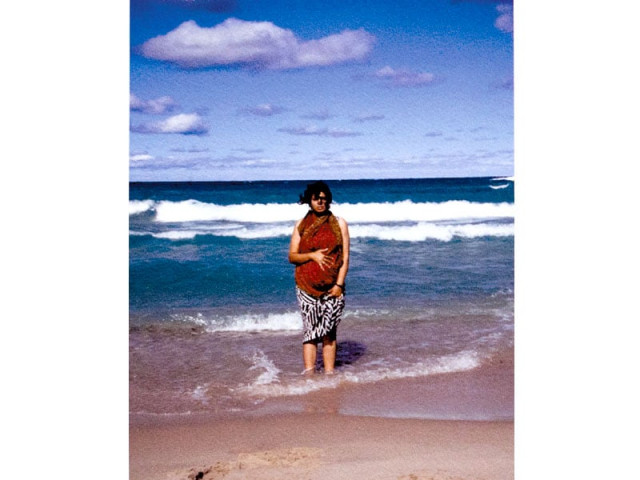Fresh faces: A new kind of art on display
Mixed reviews by viewers over ‘non-traditional’ photography style.

The prints were left deliberately small to draw the viewer as close as possible. PHOTO: MYRA IQBAL/EXPRESS
When pop-art virtuoso Andy Warhol predicted a future where everyone could be famous for 15 minutes, he was referencing a digital age that would craft a sense of marvel in the banal and prosaic.
The photographic exhibit “Who Am I to Blow Against The Wind”, featuring 46 pieces, opened at the Satrang Gallery on Thursday and will continue for a month. The event aims to transform intimate glimpses inside the lives of artists Shalalae Jamil and Lali Khalid into such a Warhol-esque intrigue.
By inviting the viewers to engage with deeply personal snapshots — whose eventual place is a family-album as a trigger for memory — curator Zahra Khan challenges the narrative of ‘being’.

“The images appear to be deceptively simple. A baby at bath time, or a napping lady, but the photographs are immersed in layers of metaphor and inquiry,” Khan, who is based abroad, explains in her curatorial statement.
Much in the way that memory wrestles with continuity and chronology, the unframed photographic prints were put up on the walls as pieces of a whole, rather than a flowing narrative. The prints were left deliberately small — the largest 16 by 20 and the smallest three by five — in a bid to draw the viewer as close as possible.
Khan suggests that this interaction serves to erase the boundaries between the artist and viewer, allowing the latter to feel as if “he is embraced” and “invited into the inner circles of family”. This analogy, however, did not sit well with the exasperated viewers at the opening.
“This is a very challenging way to present art,” Haider Raza related. Raza, the founder of a website offering luxury auctions explained
that the absence of a “journey” and “structure” within the display created a strong disconnect between the observer and the art.

The work of both Khalid and Jamil is tied loosely through the concept of family, and inherently, memory. However, Khalid’s photographs hint at a sense of isolation the artist feels within the confines of her geography, while Jamil’s work is more nostalgic and rooted strongly in the idea of tradition and connection. The sombre, light-and-shadow imagery of the former is a welcome contrast to the colourful, and sometimes monochrome but airy palette of the latter.
Khalid’s work is largely self-portraiture juxtaposed in interior and exterior environments that suggest containment and ambivalence. A particularly striking image is one that breaks out of this aesthetic mould through its confrontational composition and vivid use of colour. Khalid is framed in the centre of a beach, under a vibrant blue sky and foamy waves, a light breeze playing with her hair. She holds her stomach, which the caption explains is the “centre within the centre” as an expression of the overwhelming emotion that precedes new motherhood.
“She looks like Venus from the Botticelli painting (The Birth of Venus),” shares Hassan Yaqub, peering closely at the image.
While Khalid’s work is characterised by a sense of drama, Jamil’s work is to the contrary — she is an insider within the inside, as she documents small events, moments and landscapes that she is most comfortable within. An image titled ‘funeral’ is a panorama of family pouring into a sunny living area, where Khalid becomes an invisible element within the room.
“A classical painter would have drawn on the human expression within this scenario,” expressed Raza, who holds that the lack of expression, and random use of light, leaves the viewer without any kind of emotional association.
Schezre Syed, a young assistant at the Satrang Gallery, asserts that in order to get pulled into the narrative, one must spend more time with it. In an age of sharing and connectivity, Syed feels that to bring the deeply personal into a gallery space is organic and fitting.
“This kind of art is new to our part of the world and that in itself explains why people don’t know what to think of it.”
Published in The Express Tribune, September 21st, 2013.



















COMMENTS
Comments are moderated and generally will be posted if they are on-topic and not abusive.
For more information, please see our Comments FAQ